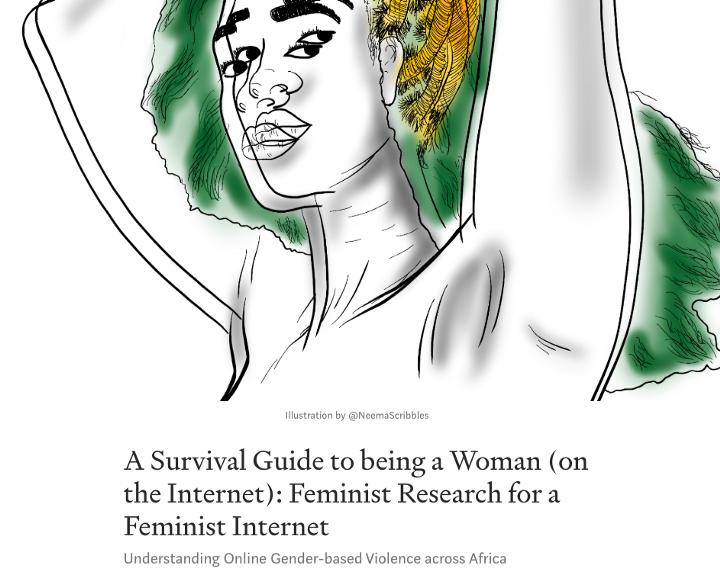
Image description: Illustration of woman against purple circle. Illustration by @neemascribbles
Sandra Nalubega supported in writing this article and we also want to thank Tigist Hussen and Erika Smith for their time and adding to our knowledge on this topic.
Feminist Internet Research on Cyberharassment: Re-victimization or Recuperation?
Last month, we (Pollicy and Berhan Taye) introduced our project on examining online or technology-facilitated gender-based violence in the African context through our blog titled, “A Survival Guide to Being a Woman (on the Internet): Feminist Research for a Feminist Internet”. In this blog, we will use I interchangeably for both Neema and Berhan.

Image description: Woman with hands raised. Illustration by @neemascribbles
As part of this research within the Feminist Internet Research Network*, we started thinking about the differences between physical and online violence, and the way we collect information and stories from victims/survivors in the process of creating knowledge.
One of the foremost ethical concerns for researchers and ethics committees is to ensure the benefit derived from research outweighs any potential harm to participants. How do we weigh this harm and benefit? How do we ensure that harm is eliminated to the greatest degree possible. This can present a particular challenge in research where participants have experienced abuse or violence, as these participants are already in a vulnerable position[1]. Online violence research is one such example. Online violence are acts committed, abetted or aggravated, in part or fully by the use of information and communication technology (ICT)[2].
Research on sensitive topics such as abuse and violence (including online violence) is necessary to generate an understanding of risk factors and potential interventions to address these concerns, and it can lead to action and support for survivors, as well as interventions that can prevent future abuse and violence. In most cases it brings benefits (such as a sense of community, someone to listen to you, and even relief) as well as harms (including becoming upset or distressed and worst of all, re-traumatization). So, in every research study, ethical considerations must be made about the risk-benefit ratio of the project. Emphasizing primarily on the risks further contribute to a lack of knowledge on a sensitive issue but an under-recognition of potential harm may disregard the impact, especially emotional, of this type of research on participants [3].
Emphasizing primarily on the risks further contribute to a lack of knowledge on a sensitive issue but an under-recognition of potential harm may disregard the impact, especially emotional, of this type of research on participants
What exactly constitutes sensitive research is up for debate. A number of people may disregard t he emotions of those distressed by online harassment as mere words or an online/disconnected experience. Here sensitive research most often refers to research about emotionally difficult topics that require participants to face issues that are deeply personal and possibly distressing. Sensitive research can also involve topics that may be taboo within a certain cultural context, too intrusive of one’s private life, stigmatising, illegal and/or potentially dangerous or research that puts participants in a situation that they may find distressing to participate in[4]. Unless we remember to conduct our research in a sensitive manner, there may be this kind of re-victimisation, where we ask questions to participants with the aim of digging up these traumatising memories, for whatever end or purpose we have in mind: knowledge building, documentation, advocacy, law-making etc.
A few studies have looked into whether asking questions to those who have experienced abuse and victimisation forces them to relive the trauma. This question is further complicated when deciding whether to ask the same questions to youth or adolescents as opposed to adults[5]. This is something we grappled with within our research design. Online bullying can start at a very young age, but we need to take special care when talking to adolescents, and for this research, we opted to only include adults. Are we missing out on important information on how to protect children and adolescents? Yes, we just didn’t have the resources to take this special care at this stage, and for us, it was more important to minimise harm
As human subject protections strengthen over time, concern about potential harm in research on emotionally distressing topics has become increasingly important, especially in the context of no benefit for participants. These concerns include psychological risk, anxiety, trust issues, shame, fear, frustration, inconvenience, but more so a feeling of a lack of support. If you interview someone about the online harassment they face, are you also expected to offer solutions?
On the flip side, what about the benefits?
Some of the participants we spoke to in our in-depth interviews said that they felt that being able to answer our questions was therapeutic or cathartic. To have someone to talk to about their experience. What benefits can such research present to participants where we previously thought there was none? The opportunity to discuss their experience, to learn about resources, new insights, feelings of well-being, improvements in health, and the potential to help others.[6] [7]
While it is expected for some participants to report unexpected distress, some research has actually shown that more numbers report gains from participation, recognizing that while it is difficult, it is also helpful.
Trauma survivors “are not too fragile to participate in trauma research even in the acute aftermath of a traumatic experience”
- Participation in Trauma Research: Is There Evidence of Harm?
Michael G. Griffin, Patricia A. Resick, Angela E. Waldrop, Mindy B. Mechanic[8]
Research that is emotionally charged or sensitive can open up new spaces for new questions, new ideas and new interpretations of both[9]. It can challenge previously held concepts of subjectivity, objectivity and experience and open doors for new knowledge to be developed and explored[10].
But what about survivor porn?
Word to the wise, do not Google “survivor porn”.
I came across this interesting blog and podcast titled “The Ethics of Nonprofit Storytelling: Survivor Porn and Parading Trauma” interviewing Sophie Otiende who works at HAART in Kenya.
“Think about the power that organization holds over this victim, and then think about consent. Think about whether that victim — that survivor — would actually be able to give proper consent about telling their story.”
The interview examines the ethics of non-profit storytelling and how survivors of trauma are often asked by non-profits to provide an “emotional hook”.
Take for example this email we received a few days before I wrote this blog. We set up a hotline and a chat bot, Wetaase, to streamline referrals for people looking for information, victims, and survivors in Uganda as part of our civic technology initiatives. We receive many such emails and requests.
Where do we draw the line between building knowledge versus parading trauma for our causes?

And What about Us?
Last week, after a meeting in my office, a colleague and I walked out to get a drink of water. Our Research Manager had her head in her hands, looking down at her laptop. We asked her what was wrong, and she said that she was reading the focus group transcript. And how disturbing it was.
Throughout this process, we had been thinking about our participants. But what does it mean for us, the researchers? For our data collectors?
Vicarious Trauma can be defined as the transformation of the researcher’s inner experience due to empathetic and/or repeated engagement with survivors of violence and their trauma
Vicarious trauma can be a very real problem for researchers who work on topics such as sexual violence. Vicarious Trauma can be defined as the transformation of the researcher’s inner experience due to empathetic and/or repeated engagement with survivors of violence and their trauma[11]. The multitudes of stories of pain from our participants can have lasting emotional impacts.
A key factor in the ability to care for others is the ability to care for oneself.
-H. Helm, A. Williams, and J. Carden[12]
In our research, we hear comments such as “If you don’t like it, you can just leave social media”, “It’s just words”, “It’s harmless, get over it”. But listening to the stories, it’s much bigger than this. People have taken their lives over cyberbullying and harassment. There is real pain and hurt, as our physical and digital merge into one. How do we feel empathy in its full form, while still protecting our own mental health? What are our coping strategies? It’s not enough for us to just say #selfcare, what does it really, really mean? And what can we do for future researchers, for content moderators, law enforcement agents who will increasingly have to deal with cases of online gender-based violence?
Final Thoughts
Our aim when we joined the Feminist Internet Research Network was to understand how women living in Kenya, Senegal, and South Africa experience the internet. We specifically wanted to document online gender-based violence and if possible, to help improve women’s experiences online. From the get-go, we were conscious of the challenges this research poses to us as women researchers who have previously been harassed online and to the 3000+ women participants.
We had to be intentional by acknowledging our ambitions and privileges, revising, and reworking our approach countless times. Even now, after we have concluded research in one country and as we get ready to do the same in the other two countries, we have to re-examine our approach and strive to do better to minimise the risk and increase the benefit to our research participants.
To be honest, as we talk to more women and hear more stories about how unforgiving the internet can be to women, we sometimes have to admit that we may have taken on more than we can actually carry. These women have trusted us with some of the most emotionally charged moments in their lives and while every story has affected this research for the better, we fear that our research and results might not effect the positive change and solution to every person that shared their story with us.
These women have trusted us with some of the most emotionally charged moments in their lives and while every story has affected this research for the better, we fear that our research and results might not effect the positive change and solution to every person that shared their story with us.
Going in to do this research, we were definitely apprehensive on how our interviews might be interpreted but through talking to our participants, we have learned immensely and learned how important it is to give space to people to talk about their experiences, positive and negative.
At the beginning of this piece, we commented that it is worthwhile to do research on sensitive topics if the risk out-weights the benefit. Every story we hear forces us to ask this simple question — how can we actually make sure that the findings of this research benefit each and everyone that shared their story with us and improve the experience of women online?
Footnotes
[1] Jodie Valpied, A. C. (2014). Sometimes cathartic. Sometimes quite raw”: Benefit and harm in an intimate partner. Retrieved from http://dro.deakin.edu.au/eserv/DU:30069266/taket-sometimescathartic-post-2014.pdf
[2] Association for Progressive Communications. (March 2015). From Impunity to Justice:Domestic legal remedies for cases of technology-related violence against women. Retrieved from http://www.genderit.org/sites/default/upload/flow_domestic_legal_remedies.pdf
[3] Tracy McClinton Appollis, C. L. (2015). Adolescents’ and Adults’ Experiences of BeingSurveyed About Violence and Abuse: A Systematic Review of Harms, Benefits, and Regrets. Am J Public Health. Retrieved from https:/www.ncbi.nlm.nih.gov/pmc/articles/PMC4318302/
[4] Angela Melville, D. H. (May 2016). Conducting Sensitive Interviews: A Review of Reflections. doi:10.5553/REM/.000015
[5] Anderson, N. (2014). Does Asking Victimized Youth Sensitive Questions Cause Additional Distress and Trauma? Evans Evaluation. Retrieved from http://evansevaluation.com/more/white-papers/
[6] Newman E, K. D. (1997). Ethical issues in trauma research. (O. o. Sage, Ed.) 271-281.
[7] Newman E, R. E.-A. (2006). Ethical issues in trauma-related research: A review. Journal of Empirical Research on Human Research Ethics. 2006;, 1(3), 29–46.
[8] Griffin MG, R. P. (2003, June). Participation in trauma research: is there evidence of harm? 16(3), 221-7.
[9] Heather R. Hlavka, C. K.-L. (2007). Revictimizing the Victims? Interviewing Women About Interpersonal Violence. 22(7). Retrieved from http://citeseerx.ist.psu.edu/viewdoc/download?doi=10.1.1.824.6334&rep=r…
[10] Blakely, K. (2007). Reflections on the Role of Emotion in Feminist Research. 6(2). Retrieved from https://sites.ualberta.ca/~iiqm/backissues/6_2/blakely.pdf
[11] Jan Coles, E. D. (2013). “Preventing the Pain” When Working with Family and Sexual Violence in Primary Care. doi:10.1155/2013/198578
[12] G, H. (1983). Human and social consequences of research. Progress in Clinical Biological Research. Retrieved from https://www.ncbi.nlm.nih.gov/pubmed/6634734
Additional References:
James A Roffee, A. W. (n.d.). Resolving ethical challenges when researching with minority and vulnerable populations: LGBTIQ victims of violence, harassment and bullying. 13(1)(4-22). doi:10.1177/1747016116658693
JE., S. (2000). Planning research: Basic ethical decision-making. Ethics in research with human participants. Washington, DC: American Psychological Association. Sieber JE.Sales BD, Folkman S.
Peter G. van der Velden, M. W. (2013). The Burden of Research on Trauma for Respondents: A Prospective and Comparative Study on Respondents Evaluations and Predictors. Retrieved from https://journals.plos.org/plosone/article?id=10.1371/journal.pone.00772…
Susan M. Labott, T. P. (n.d.). Emotional Risks to Respondents in Survey Research: Some Empirical Evidence.
- 6685 views







Add new comment